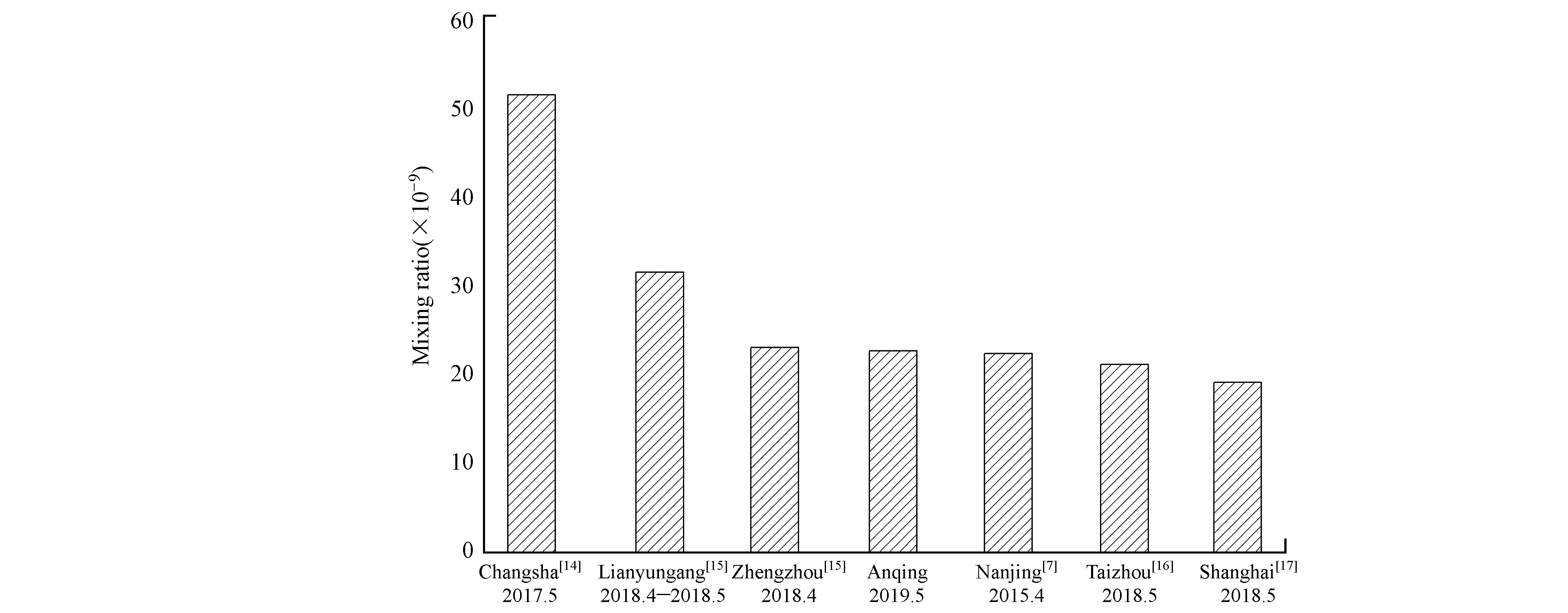-
近年来,随着我国大气污染防治工作的逐步推进,全国范围内环境空气质量总体改善。与2017年相比,2018年我国大部分城市的PM2.5、PM10、NO、COx和SO2等污染物浓度和超标天数均下降,而O3浓度和超标天数比例均增加,臭氧污染问题逐渐凸显[1]。VOCs可以和氮氧化物发生光化学反应形成光化学烟雾,也可与大气环境中的氢氧自由基、硝酸自由基、臭氧等氧化剂发生多途径反应,生成二次有机气溶胶,对环境空气中的臭氧和PM2.5有重要影响,直接或间接的影响着人体健康和环境空气质量[2-3]。基于PM2.5和O3污染的协同调控已成为我国在大气污染防治方面亟需解决的关键问题,从VOCs污染特征着手直接分析其对臭氧生成与影响的研究十分必要。
目前,国内已开展了大量关于VOCs的浓度水平、污染特征、化学反应活性和污染物来源等研究,如北京[4-5]、上海[6]、南京[7]、天津[8]、郑州[9]、合肥[10]等地。安庆市位于长江中下游北岸,是安徽省西南部重要的工业城市。随着安庆市经济的快速发展,能源消耗持续上升,大气污染问题频发。据安庆市环境质量公报显示,2018年安庆市环境空气质量优良率只有77%,首要污染物以O3和PM2.5为主,分别占144 d和116 d。VOCs是臭氧和二次有机气溶胶产生的重要前体物,但目前尚未见到研究安庆市大气中VOCs的相关报道。
本研究于2019年5月对安庆市城区大气VOCs开展了为期1周的定点离线观测,分析VOCs的浓度水平和组分特征,估算VOCs的化学反应活性,筛选出VOCs关键活性组分,以期为安庆市大气污染防控提供科学支撑。
全文HTML
-
本研究采样点位于安庆市环境空气国控监测点马山宾馆西北侧200 m处的吾家宾馆楼顶(30°31′N,117°2′E),测点离地高度约21 m。该点位地处安庆市城区,周边分布着商业区、居民区和政府机关等,监测数据能基本反映安庆市城区的污染状况。观测时段为2019年5月15日—5月21日,连续监测1周。样品采集使用抽真空的SUMMA罐,采样罐容积为6 L,采样流量3.8 mL·min−1,采样时间为当天10:00—次日10:00,采集完成后避光室温保存,确保10 d内完成分析。
-
通过预浓缩仪(Entech 7100预浓缩仪)和气相色谱质谱联用仪(Agilent 7890 A/5975C气相色谱质谱联用仪)完成样品分析。将VOCs样品进样400 mL,通过预浓缩仪的三级冷阱处理。在预浓缩仪中,一级冷阱捕集温度设定为−160 ℃,捕集流速为90 mL·min−1,解析温度为10 ℃;二级冷阱捕集温度设定为−30 ℃,捕集流速为90 mL·min−1,解析温度为190 ℃;三级聚焦温度设定为−170 ℃,烘烤温度为190 ℃。预浓缩处理后的样品进入气相色谱仪进行分离,设置起始温度为40 ℃,5 min后,以5 ℃·min−1速度升温至160 ℃,保持6 min后,将温度以10 ℃·min−1速度升至210 ℃,保持4 min,随后进入检测器(MS+FID)进行检测。质谱仪采用全扫描方式进行扫描。
样品的采集与分析的全过程参照《环境空气 挥发性有机物的测定 罐采样/气相色谱-质谱法》(HJ 759—2015)和《臭氧前体物采样和分析技术支持文件》(EPA/600-R-98/161)等进行,严格按照标准方法的要求,注重质量保证与质量控制。
-
·OH自由基是对流层大气中最重要的氧化剂,·OH自由基反应活性将所有VOCs组分置于同一基点上比较它们的活性,·OH自由基消耗速率可以反映VOCs中各组分对光化学反应的相对贡献,其计算公式如下:
式中,LiOH为VOCs中组分i的·OH自由基消耗速率,s−1;[VOC]i为某个组分i在大气中的体积分数,×10−9;KiOH为组分i与·OH自由基的反应速率,单位为cm3·molecule−1·s−1,计算LOH时对体积分数进行单位换算,本文中不同VOCs组分的KOH数据来自文献[11]。
-
考虑到·OH自由基消耗速率法所忽略的机理活性差异,研究者在此基础上提出了增量反应活性(IR)用来表征单位质量浓度的VOCs改变引起的臭氧生成或损耗的变化。臭氧生成潜势表征VOCs组分在最佳反应条件下对O3生成的最大贡献,其计算公式如下:
式中,OFPi为VOCs组分i的臭氧生成潜势,×10−9;MIRi是VOCs中组分i的的最大增量反应活性,单位为g·g−1,以O3/VOCs计,本文中不同VOCs组分的MIR数据均来自文献[12]。
-
本研究基于Grosjean烟雾箱实验,采用气溶胶生成系数法(FAC)估算大气中VOCs的二次气溶胶生成潜势,其计算公式如下:
式中,SOAi是VOC组分i的二次气溶胶生成潜势,μg·m−3;FVOCri是假定原始排放的VOCs反应体积分数;FACi是二次气溶胶生成系数,%。计算时将组分的体积分数换算成质量浓度计算,公式中用到的FVOCri和FACi由烟雾箱实验获得[13]。
1.1. 样品采集
1.2. 样品分析
1.3. 数据分析方法
1.3.1. ·OH自由基消耗速率
1.3.2. 臭氧生成潜势
1.3.3. 二次有机气溶胶(SOA)生成潜势
-
观测期间安庆市城区环境空气中VOCs的日均体积分数是22.53×10−9,变化范围为18.56×10−9—25.05×10−9。其中,烷烃、烯烃、炔烃和芳香烃的日均体积分数分别为11.81×10−9、4.69×10−9、3.81×10−9和2.23×10−9。烷烃占VOCs的比例最大,为52.40%,其次是烯烃、炔烃和芳香烃,分别占20.81%、16.90%和9.89%。
本研究共监测了57种VOCs组分,包括29种烷烃,17种芳香烃,10种烯烃,1种炔烃。如表1所示,体积分数最高的10种物质分别为:乙炔(16.92%)、正丁烷(12.32%)、丙烯(11.17%)、异戊烷(10.80%)、乙烷(8.29%)、异丁烷(7.68%)、乙烯(6.16%)、甲苯(4.60%)、丙烷(3.09%)、苯(2.75%),累计占VOCs的83.78%。由此可见,C2—C5的低碳烷烃、乙炔、乙烯、丙烯、甲苯和苯是安庆市城区环境空气中VOCs的主要组分。
如图1所示,选取采样时间在4—5月份的国内其他城市安庆市VOCs体积分数对比分析,发现安庆市城区VOCs体积分数远低于长沙[14]和连云港[15],略低于郑州[9],略高过长三角城市南京[7]、泰州[16]和上海[17]。
-
由于不同排放源具有特定的VOCs物种,因此可以利用特定的VOCs物种比值来初步判断VOCs的来源,通常采用甲苯/苯(T/B)来评价机动车尾气对环境大气的影响程度[18]。通常认为,T/B<2.0表明苯系物排放受机动车尾气影响显著[19],T/B>2表明苯系物排放受溶剂挥发等其他VOCs排放源影响较大[20]。安庆市城区大气VOCs采样期间,T/B比值范围为1.56—1.78,平均值为1.67,表明安庆市城区大气VOCs符合机动车尾气为主要贡献源的特征。
乙炔化学性质较活泼,在大气光化学反应中不断消耗减少,而乙烷的化学性质较稳定,因此常用乙烷与乙炔的浓度比即乙烷/乙炔(E/E)来表征大气气团的光化学年龄。研究显示,机动车原始排放的污染气团中E/E比为0.47±0.26[21]。安庆市城区大气VOCs采样期间E/E的比值范围为0.41—0.53,平均值为0.49,与机动车原始排放值基本一致,说明观测站点区域大气老化程度较轻,受本地污染排放影响较大。
-
安庆市城区大气VOCs组分的LOH和OFP贡献如表2所示。由于VOCs组分繁多,化学结构迥异,反应活性不一,导致了烷烃、烯烃、芳香烃和乙炔对大气VOCs的LOH和OFP贡献不一致。由表2可见,含量占比20.74%的烯烃,其中LOH和OFP贡献最高,依次为67.08%和69.80%;含量水平最高的烷烃(52.43%),其对LOH和OFP贡献仅为22.03%和15.89%。综上所述,烯烃类物质对安庆市城区环境空气中臭氧污染影响较大,控制烯烃类物质的排放,对改善安庆市臭氧污染尤为重要。
单个VOCs组分对LOH和OFP贡献排序如图2所示,LOH贡献占比前10的组分分别是丙烯、正丁烯、乙烯、异戊烷、反式-2-丁烯、正丁烷、异丁烷、苯、乙炔和反式-2-戊烯,OFP贡献占比前十的组分分别是丙烯、乙烯、正丁烯、乙炔、正丁烷、苯、异戊烷、异丁烷、反式-2-丁烯和间/对二甲苯。综上所述,安庆市城区环境空气VOCs的关键活性组分为C2—C4低碳烯烃、异戊烷、正丁烷、异丁烷、苯和乙炔。
-
VOCs是SOA重要的前体物之一,VOCs 在大气中经氧化生成的挥发性较低的产物通过各种物理化学过程转化为SOA[22]。本研究通过计算不同VOCs组分对SOA的生成潜势,评估不同种类VOCs对SOA生成的贡献。在测定的VOCs组分中有26种对SOA具有生成潜势,包括11中烷烃类,15种芳香烃类,还有1种烯烃即异戊二烯。
如表3所示,观测期间,SOA的生成量为0.53 μg·m−3,芳香烃对SOA的贡献率最大,高达94.09%,烷烃类和烯烃类对SOA的贡献率分别是5.05%、0.86%。在26种SOA前体物中贡献率较大的前10种VOCs组分包括9种芳香烃,1种烷烃,分别是甲苯、苯、间/对二甲苯、乙苯、邻二甲苯、对二乙基苯、间乙基甲苯、1,2,4-三甲基苯、癸烷和1,3,5-三甲基苯,其贡献率依次分别是49.30%、9.05%、7.99%、7.78%、5.69%、2.68%、2.50%、1.92%、1.88%和1.77%,共占SOA生成潜势的92.47%。
2.1. 大气VOCs的污染特征
2.2. 特征比值分析
2.3. VOCs关键活性组分
2.4. 二次有机气溶胶的生成潜势
-
(1)安庆市城区环境空气中总VOCs的日均体积分数是22.53×10−9,变化范围为18.56×10−9 —25.05×10−9。烷烃、烯烃、炔烃和芳香烃占比分别为52.40%、20.81%、16.90%和9.89%。C2—C5的烷烃、乙烯、丙烯、甲苯和苯是安庆市环境空气中VOCs的主要组分。
(2)采样期间甲苯与苯的浓度比T/B比值范围为1.56—1.78,均值为1.67,小于2,表明安庆市城区大气VOCs符合机动车尾气为主要贡献源的特征。采样期间乙烷/乙炔(E/E)的比值范围为0.41—0.53,均值为0.49,与机动车原始排放值基本一致,说明观测站点区域大气老化程度较轻,受本地污染排放影响较大。
(3)烯烃类物质对安庆市区环境空气中臭氧影响最大,含量占比20.81%的烯烃,其LOH和OFP贡献最高,依次分别为67.08%和69.80%。综合比较各组分对LOH和OFP的贡献占比,安庆市城区环境空气VOCs的关键活性组分为C2—C4低碳烯烃、异戊烷、正丁烷、异丁烷、苯和乙炔。
(4)使用FAC法估算SOA的生成潜势,结果显示,观测期间SOA总生成潜势为0.53 μg·m−3,其中芳香烃对SOA的贡献率高达94.09%,烷烃类和烯烃类对SOA的贡献率分别是5.05%、0.86%。甲苯、苯、间/对二甲苯和乙苯为贡献较大的组分。




 下载:
下载:


